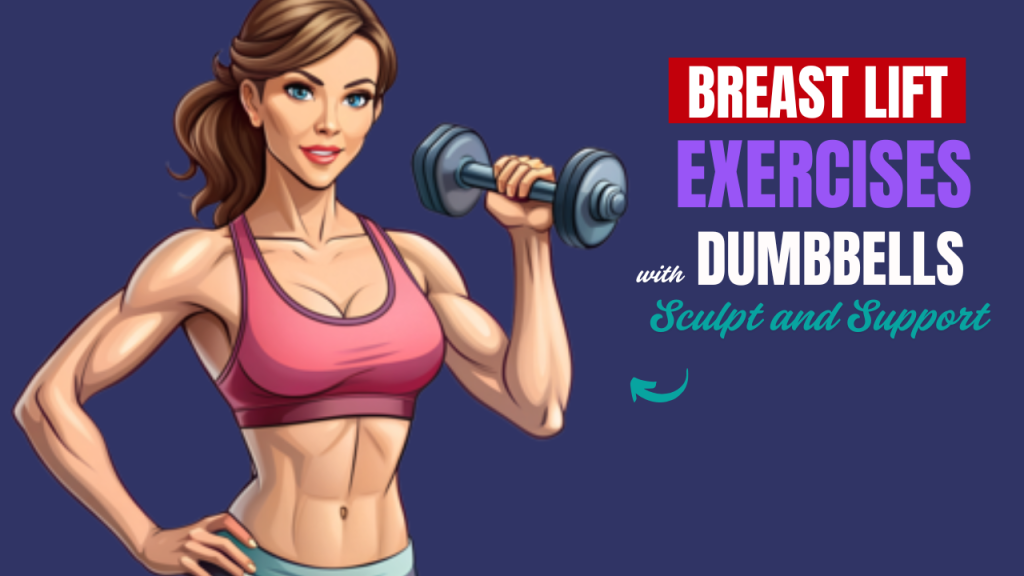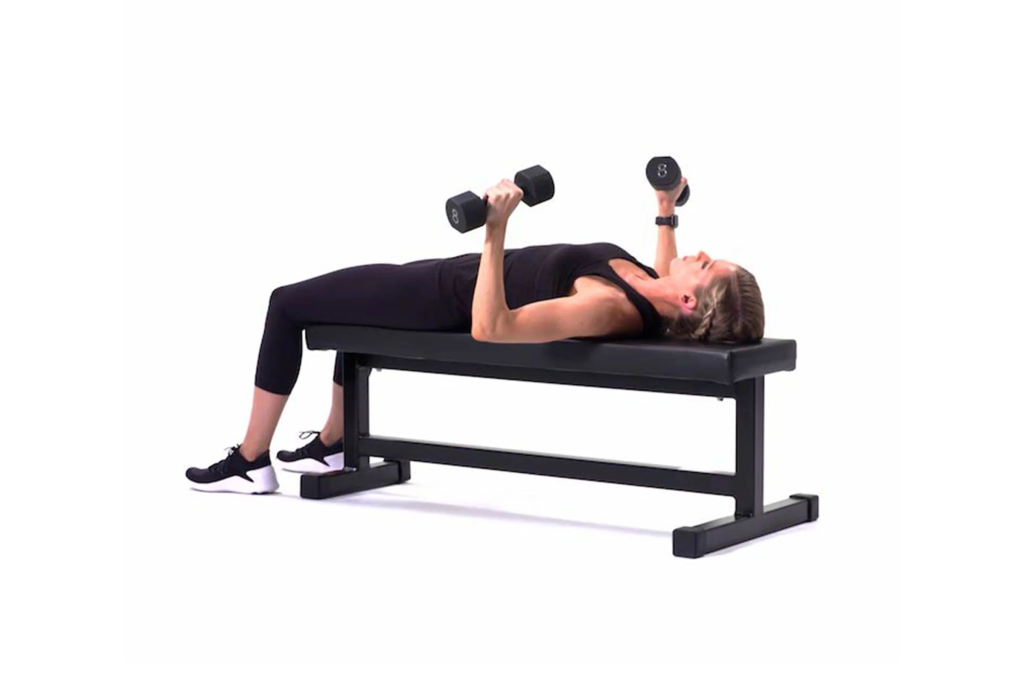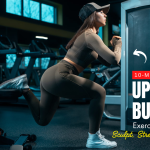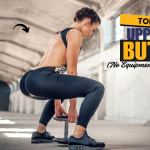Do you know that your breasts don’t have muscles—but you can still lift them naturally?
That’s right. Breasts are made up of fat, connective tissue, and glands, not muscle. However, the muscles underneath your breasts—mainly the pectoralis major and minor—play a crucial role in how lifted and firm your chest appears. Toning these muscles using simple dumbbell exercises can enhance support, improve posture, and give the illusion of a natural breast lift.
Forget surgery or expensive creams. If you’re seeking a safe, effective, and empowering way to sculpt your chest and upper body, these 5 dumbbell exercises are your go-to. Let’s explore how to naturally enhance your curves and strength—one rep at a time.

What Can Happen After 30 Days of Doing These Exercises
| Day Range | What to Expect |
|---|---|
| Days 1–7 | – Muscle soreness (DOMS) in chest and shoulders – Improved awareness of posture |
| Days 8–14 | – Slight increase in chest firmness – Better exercise form and control |
| Days 15–21 | – Noticeable strength gains – Improved shoulder alignment – More toned arms |
| Days 22–30 | – Enhanced upper body definition – Lifted appearance in chest area |
| After 30 Days | – Muscle soreness (DOMS) in the chest and shoulders – Improved awareness of posture |
Myth Busted: “You Can’t Lift Your Breasts Without Surgery”
While you can’t change the internal structure of breast tissue through exercise, you can strengthen the surrounding muscles to create a firmer, more lifted appearance. Combined with posture correction and consistent strength training, you’ll notice visible improvements in shape and support—naturally.
1. Dumbbell Chest Press
Target Areas: Pectorals, triceps, and deltoids
Why It Works: This move strengthens your chest wall, giving your bust a more lifted appearance while toning the upper arms.

How to Do It:
- Lie flat on your back on a bench or mat.
- Hold a dumbbell in each hand at chest level, elbows bent at 90 degrees.
- Press the dumbbells up toward the ceiling until the arms are fully extended.
- Slowly lower them back down.
Reps: 3 sets of 10–12
Interesting Fact: A stronger chest can improve shoulder stability and reduce the appearance of sagging.
2. Dumbbell Flys
Target Areas: Pectorals (especially inner chest)
Why It Works: This isolation exercise stretches and contracts the chest muscles, enhancing their strength and tightness.

How to Do It:
- Lie on your back with a dumbbell in each hand, arms extended above your chest, palms facing each other.
- Slowly open your arms out to the sides in a wide arc, keeping a slight bend in the elbows.
- When your arms are level with your chest, bring them back together.
Reps: 3 sets of 8–10
Did You Know? Regular flys can help reverse rounded shoulders, which often exaggerate sagging in the bust.
3. Dumbbell Pullover
Target Areas: Chest, lats, and core
Why It Works: This underrated move works the upper body from multiple angles, helping to lift and support both the breasts and back.

How to Do It:
- Lie on your back with one dumbbell held by both hands.
- Start with the dumbbell above your chest, then slowly lower it back and over your head until your arms are parallel to the floor.
- Pull it back to the starting position using your chest and lats.
Reps: 3 sets of 10
Bonus Benefit: Improves flexibility in the shoulders and strengthens the core—key components for an upright, supported chest.
4. Dumbbell Front Raise
Target Areas: Shoulders (anterior deltoid), upper chest
Why It Works: Strengthening the shoulders not only balances your frame but also keeps the chest lifted and aligned.

How to Do It:
- Stand with feet shoulder-width apart, holding a dumbbell in each hand.
- Raise your arms straight in front of you to shoulder height, palms facing down.
- Pause briefly, then lower slowly.
Reps: 3 sets of 10
Posture Tip: Strong shoulders naturally prevent the forward slump that makes the chest appear droopy.
5. Incline Dumbbell Press
Target Areas: Upper chest, shoulders
Why It Works: By focusing on the upper part of the pectoral muscles, this move promotes an uplifted, toned look.

How to Do It:
- Set a bench at a 30-45 degree incline.
- With a dumbbell in each hand, press them from chest level upward at an angle.
- Lower with control.
Reps: 3 sets of 8–12
Pro Tip: This is a favorite among fitness trainers for a natural chest lift effect without bulk.
Final Thoughts: Confidence Comes From Strength
Building chest strength isn’t just about appearance—it’s about how you feel in your body. Regularly doing these dumbbell exercises can enhance upper body tone, improve posture, and give your chest a naturally lifted look. And the best part? It’s all within your control—no surgeries, no shortcuts.
Stick to these movements 2–3 times per week, and you’ll begin to see and feel the benefits over time. Pair this routine with hydration, good posture, and a balanced diet, and you’ll have a holistic approach to sculpting and supporting your body—naturally and confidently.
Frequently Asked Questions (FAQs)
Can dumbbell exercises really lift my breasts?
While exercises can’t change the structure of breast tissue, they strengthen the underlying chest muscles (pectorals), which can enhance the shape, support, and firmness of the bust. This often results in a more lifted and toned appearance.
How often should I do these breast lift exercises?
For best results, aim to do these exercises 2 to 3 times per week, allowing at least one rest day between sessions. Consistency is key to building muscle tone and seeing visual improvement.
Do I need heavy weights to see results?
Not at all. Light to moderate dumbbells (3–10 lbs) are sufficient, especially if you’re focusing on form, control, and consistency. As your strength improves, you can gradually increase the weight.
Will these exercises reduce breast size?
These exercises may lead to fat loss around the chest area if paired with overall weight loss. However, their main effect is toning and lifting, not shrinking. They won’t drastically reduce breast size unless part of a broader fat-loss routine.
Can I do these exercises at home without a bench?
Yes! You can modify the workouts using a yoga mat, stability ball, or even the floor. An incline bench is helpful but not required for beginners.
Are these exercises suitable for all ages?
Absolutely. These movements are low-impact and adaptable, making them safe for most age groups. However, if you have any medical conditions or injuries, consult a fitness professional or healthcare provider first.
How long before I see visible results?
Most people begin to notice improved tone and posture within 4–6 weeks, depending on consistency, diet, and overall activity level. The key is staying regular and patient.
Can these exercises improve posture too?
Yes! Many of these dumbbell moves—like chest press, flys, and front raises—engage the shoulders and upper back, helping correct rounded posture, which in turn makes the chest appear more lifted.





